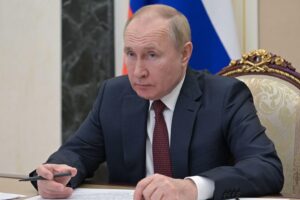Czech arms manufacturers have seen their reputations transformed, from being a burden on the country’s international image to the government’s main conduit of support for Ukraine.
The future of the Czech Republic’s once-strategic armaments industry was endangered by the loss of markets and privatisations in the 1990s. Its revival in the 2010s, fuelled by profitable yet controversial exports of outdated Soviet-era weapons to authoritarians and war zones around the world, harmed the country’s international reputation and often put the arms markers and suppliers at odds with the government.
Yet the Russian aggression against Ukraine has completely changed the landscape and provided these manufacturers with a big opportunity to export their products to a war zone of geopolitical importance for the Czech Republic.
The political leverage of the arms suppliers has consequently increased as they transformed themselves into the government’s vital partner in support of Ukraine. However, for an industry that appeared to care little for human rights and ethical standards in the past, the government should remain wary about loosening regulation over rapidly growing arms production centred on outdated weapons systems.

The tradition of the (Soviet) arms industry
Czechia has a long tradition of heavy arms manufacturing dating back to the Austro-Hungarian industrialising times, which was further developed during the interwar period. Present-day production capacities were largely inherited from the Cold War era when Czechoslovakia served as an important arms supplier for the whole of the Eastern Bloc.
Until the 1990s, Czechoslovak factories produced huge amounts of materiel, mainly under Soviet licenses, including aircraft, tanks and heavy artillery. The sector employed more than 90,000 workers in dozens of factories scattered across the country, which supplied weapons not only to the Czechoslovak Army subordinated to Soviet command, but also to its allies in the Warsaw Pact and for export to politically aligned governments across the developing world.
By way of illustration, between 1945 and 1992, Czechoslovak factories produced over 50,000 tanks and armoured vehicles. Of this number, the Czechoslovak Army took delivery of about a third, while the larger part was successfully exported to other states of the Eastern Bloc, Africa and the Middle East.

Post-1990 doldrums
The collapse of the Communist regime in 1989 and subsequent dissolution of Czechoslovakia caused a political and economic shock to the country’s arms industry, which subsequently lost its strategic importance and most of its markets.
Under the new democratic system, the Czech military was reformed, professionalised and substantially reduced. On its way to joining NATO structures, the armed forces made a strategic decision to gradually replace its outdated Soviet-era weapons with much smaller amounts of modern Western systems. While the newly established Czech Army still possessed almost 1,000 old Soviet tanks in 1993, it only retained 30 upgraded pieces which have recently been shipped off to Ukraine in exchange for new German tanks.
As the defence budget was significantly reduced and domestic producers could not provide the armed forces with weapons up to NATO standards, the state’s interest in the once-strategic arms industry began to waver. Similar developments took place in other post-Communist countries, meaning Czech arms producers began losing their foreign markets too.
Because of the global geopolitical shifts after the end of the Cold War and the technological superiority of Western weapons, the country’s arms industry oriented on obsolete Soviet technologies lost many export opportunities to the developing world. As a result of the loss of markets, the volume of arms production by the mid-1990s had fallen to just a tenth of that in the late 1980s.
With the sector on the brink of bankruptcy, the state monopoly was lifted and many of the production capacities were privatised, sometimes under dubious circumstances. Instead of the development and production of new weapons, however, many of the new private companies either converted to civil production or reoriented to the modernisation of Soviet-era weapon systems previously manufactured in the country.

Silent consent and restrictions
The state played an important role in the growth of this dubious arms business. While the weapons were mainly sold to war zones by private companies, all of the exports had to be formally approved by government bodies.
Under the Czech licensing system, each export of military technology has to be cleared by the Ministry of Industry and Trade, with the Ministry of Foreign Affairs providing an assessment of compliance with the country’s foreign policy interests and international obligations.
Although the ministries have been generally acquiescent over arms exports to countries engaged in armed conflicts, they occasionally blocked some of the most problematic deals based on concerns about the materiel’s further proliferation to unknown end-users. These single restrictions irritated arms producers, who openly criticised the government for a too-restrictive approach that allegedly disadvantaged the Czech arms industry on international markets.
Meanwhile, some of the key people in the arms sector became involved in high-level politics, raising questions about possible conflicts of interest. While the chairman of the Defence Industry Association and chief lobbyist for arms producers, Jiri Hynek, unsuccessfully ran in the presidential election in 2018, the owner of the largest weapon producer CSG, Jaroslav Strnad, sponsored the political career of former president Milos Zeman.
Russian aggression rehabilitates arms industry
The Russian invasion of Ukraine in February 2022 completely changed the dynamics within the arms industry and its relations with governments, not only in Czechia but across Europe. The sector hitherto labelled politically as “unsustainable” suddenly became a vital partner for governments that urgently needed to strengthen their own defence capacities and at the same time supply Ukraine with weapons.
From the very outset of the war, the Czech government has been one of the strongest European supporters of the Ukrainian military. Czechia was the first country to supply heavy weapons to Ukraine in April 2022 and the shipments have continued since.
The country’s arms industry oriented on the modernisation of Soviet-made weapons turned out to be a key asset in Czech military support to Ukraine. As Prime Minister Petr Fiala revealed in February, after months of stated ambiguity, military materiel worth 1.8 billion euros, including hundreds of Soviet-made heavy weapons, was delivered from Czechia to Ukraine during the first year of the war.
The government also admitted that only about a quarter of that volume was provided by the state, mainly from the surplus and outdated army stockpiles. The Czech military has been compensated for these weapons shipments to Ukraine by generous military and financial aid from its NATO and EU partners.
Meanwhile, the majority of the weapons were supplied to Ukraine by private arms producers and funded by Western donors. The government also brokered a deal between Czech private arms producers and Ukrainian state arms enterprise Ukroboronprom on joint production and modernisation programs in Czech factories. Besides the obvious geopolitical motivation, the deputy defence minister justified this step by the prospective economic profit for Czech arms producers.
The data about the origin of weapons and funds show clearly that what has been politically presented in simplified terms as Czech military support to Ukraine is in fact largely a profit-oriented business of Czech private arms producers financed by Western governments.

What happens after the war?
The economic and political position of arms producers has been boosted significantly by the Russian invasion as their capacities are currently indispensable to Czechia and other Western states in their support of Ukraine. Even so, it’s unclear how the dynamics of relations between governments and the arms industry will develop once the hostilities in Ukraine end.
Arms producers have emerged from the war with substantially increased production capacities and a politically powerful position that will provide them with leverage to reduce regulation of the arms industry. Aware of their strengthened bargaining position, Czech arms makers have already started campaigning for the lifting of existing restrictions on commercial banks lending to the arms sector.
However, in the specific context of the Czech arms sector oriented on Soviet-made technologies, political and military demand for supplies and repairs of obsolete weapons should presumably decrease over time. Czech producers will once again have to seek new markets for their products.
The controversial businesses in the 2010s makes it clear that Czech arms dealers are flexible in seeking buyers once they lose local demand. Profitable exports to authoritarian regimes and conflict zones also revealed they do not much care about human rights and ethical standards when making those deals.
Although political support for the Czech arms sector is fully reasonable under the current geopolitical circumstances, looser deregulation and unlimited increases in production capacities might create a future trap for the government.
Instead of giving the arms suppliers a blank cheque, a debate on the long-term political and economic sustainability of the sector should be held before it is too late.
Source: Balkan Insight











